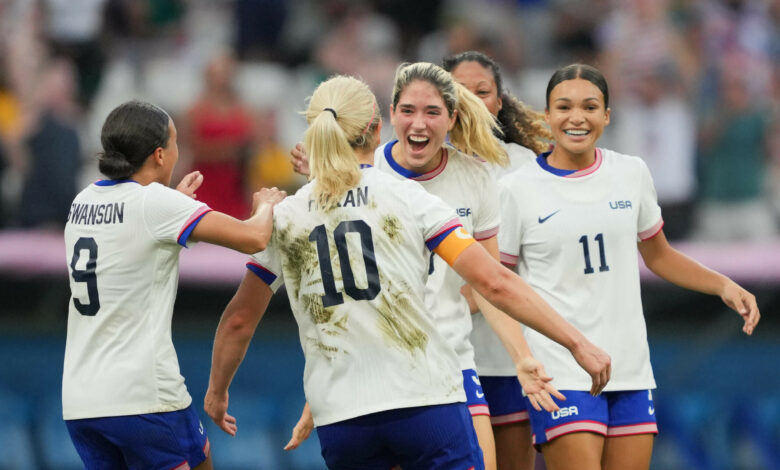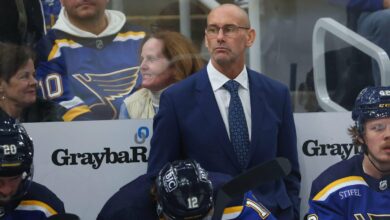USWNT 2 Australia 1: Korbin Albert helps U.S. head to Olympic quarterfinal undefeated

If it’s not broken, don’t fix it. That’s the approach U.S. women’s national team head coach Emma Hayes appeared to take in the Group B finale against Australia on Wednesday. With a quarterfinal spot already locked down, Hayes made just one change to her starting line-up, adding Emily Sonnett to the defensive line, while center back Tierna Davidson remained off the game-day roster with a knee contusion. This also means Hayes started two players, Sam Coffey and Trinity Rodman, who were one yellow card away from suspension.
For her part, Rodman tallied the team’s opening goal, cleaning up a shot from Sophia Smith after a U.S. corner. She stayed in the game for another half-hour through the break before Hayes took her off the field. Coffey, meanwhile, earned a second yellow in the fourth minute keeping her out of the team’s quarterfinal match.
Hayes eventually made a triple change in the 65th minute, taking off Rodman, Rose Lavelle and Emily Fox and adding Lynn Williams, Casey Krueger and Korbin Albert. Albert’s substitution proved crucial as the controversial midfielder scored the team’s second, and ultimately winning goal in a 2-1 victory over Australia to capture the top spot in Group B.
It wasn’t just the cautionary element that caused concern over the lack of rotation. With a game every three days, the physical strain on players was also a cause for worry. Steph Yang and Jeff Rueter take a look at what the Group B finale means for the U.S. as they head to the knockout stages.
Korbin Albert secures the win for USWNT
Few players have been discussed as often as Korbin Albert throughout 2024. At first, it was for her impressive composure in midfield as she and Coffey emerged as vital members of the squad during the USWNT’s triumphant W Gold Cup run. Soon, it was one of scandal after anti-LGBTQ social media activity resurfaced online, including one post on TikTok that included a sermon given in a Christian worship space talking about how being gay and “feeling transgender” is wrong.
Albert issued a written statement of apology in the immediate aftermath but has since said very little to the media or the fanbase. Hayes has backed the player, both with spoken endorsement in the wake of vocal criticism and audible boos during her first friendlies as coach in June (“I want to make sure our players when they come out and play for us they feel supported by all of us”) and by selecting her for this 18-player squad.
“She’s always wanting to work on improving herself,” Hayes said after the game. “I’ve had a good chance to build my relationship with her and now understand the work she’s doing as a young person. We all know that she’s been through a lot with her actions and she’s someone who is truly sorry for what she’s done and has done a lot of work on understanding not just the implications of her actions, but she’s a really inclusive person and she’s really thoughtful and kind and she’s had to do a fair bit of growing up.
“The outside world always wants to know what work people do but I’m a mother and my instinct is to protect and I’m not ever going to change that. But I don’t tolerate an environment that isn’t self aware and self reflective. … I’m proud of her because contrary to what anyone will say, when you’re a young person, you’re having to endure a lot of abuse, that’s a lot to take for a young person and she’s had to grow up and that growing is happening and I’m proud of that and I want to support her to grow.”
Thus far, Albert’s involvement has been that of a rotational option. She came off the bench in the opener against Zambia and sat for the duration of the USWNT’s win against Germany. On Wednesday, she was brought off the bench in the 65th minute. Her first involvement was an ill-advised yellow card in a sequence that didn’t warrant so much physicality.
Her second major involvement was far more positive: a dazzling strike from 25 yards out that curled into the upper corner in the 77th minute. With the wonder goal, Albert became the first United States player to score their first senior international goal in the Olympic Games.
“I’ve been just working at it in practice and mentally and just trying to like focus on it,” Albert said after the game. “And then it just happened and actually closed my eyes and then I opened it and I was like, ‘Oh my god.’ I was really nervous.
“I liked those shots. Outside the box and just the long driven ones. They don’t always go as planned, but when they do, it’s very satisfying.”
The United States doubles its lead over Australia on Korbin Albert’s first international goal! #ParisOlympics
📺 E! and Peacock pic.twitter.com/zTE7VulYYy
— NBC Olympics & Paralympics (@NBCOlympics) July 31, 2024
Under Hayes, the United States has struggled to find a way to impact the scoreline without leaning heavily on their three star attackers. Fourteen of the first 16 goals scored in her tenure saw at least one of Rodman, Smith or Swanson involved as scorer or assister. For Albert to uncork an unassisted shot from deep does serve as a signal of intent for future opponents: someone beyond the front line is up for a strike.
Her teammates who shared the field with her at that moment were eager to celebrate her milestone. All U.S. players in proximity rushed to crowd the newly minted USWNT goalscorer, smiling and hugging as they have with every other goal of the tournament. The goal proved to be a vital bit of insurance, as Australia managed a goal in the first minute of second-half stoppage time to threaten to flip the result.
“As a little girl, you’ve always dreamed of having those types of goals and when you come to this level, when you just do that thing that you dreamed about, it just feels very rewarding,” Albert said. “And not only that, but you’re helping your team get to the next level and that’s all I want.”
Instead, Albert’s first international goal doubled as match winner, ensuring the USWNT a spotless 3-0-0 record in group play.
Jeff Rueter
Why didn’t Emma Hayes make more line-up changes?
Emma Hayes did not rotate her starting XI at all for this game, Sonnett notwithstanding. It’s a notable decision for multiple factors: there are tired legs at this stage in the tournament that were in evidence even in the previous match against Germany, the lack of trust in her bench (or perhaps undisclosed injury woes), and the danger of starting two players sitting on yellow cards in Rodman and Coffey.
Coffey immediately earned a yellow in the opening minutes of the match, which disqualifies her from playing in the quarterfinals. With Coffey out, the obvious replacement for her is Sonnett as a deep-lying midfielder, but Sonnett is already having to fill in for Davidson, who is currently out with a knee injury sustained in a collision while playing Germany. Maybe that pushes Sonnett into the midfield and Krueger into a starting position, assuming Davidson still isn’t available by Saturday.

Hayes has made much of the versatility of the players on her roster, but they’re already managing young Jaedyn Shaw, who hasn’t been available at all in the group stage due to a leg injury, and now they also have to manage Davidson’s knee. Hayes has been vocal about wanting Albert in midfield. At halftime, Hayes only made one change, bringing in Jenna Nighswonger for Dunn in a one-to-one sub, asking Nighswonger to push high from her left fullback position. It was hard to watch the singular sub as Coffey again ended up in a hard challenge that could have earned a second yellow. She later made the triple sub that changed the game.
The U.S. has been playing well, but the Olympic pace tells on even the strongest of legs, and tired legs lead to increased injury risk. Hayes said before this game that she felt the team, particularly the front three, needed more minutes and more momentum from playing together. And she can’t be ignorant of the load this puts on the players. This situation demonstrates why it was so risky for U.S. Soccer to have hired Hayes on the timeline they did, only affording her a couple of months and four friendlies’ worth of experience before being thrust into her first major international tournament as a national team head coach.
Steph Yang
What happened with VAR?
VAR! What is it good for?
After Rodman scored the first U.S. goal in the 43rd minute, Australian players complained about Coffey being in an offside position, claiming she interfered with the play. The referee was seen walking over to both countries’ coaches and explaining his decision while commentator Jon Champion speculated on NBC’s broadcast that VAR was malfunctioning. Australia head coach Tony Gustavsson continued to protest, which earned him a yellow card. Meanwhile, the referee was called back yet again and given a mysterious headset, on which he listened for lengthy moments, before running to the functional VAR screen. His review of the play was almost perfunctory before signaling yet again that he was allowing the goal. Meanwhile, the first half received 10 minutes of stoppage time.
After the game, Gustavsson explained what he saw happen: “I did apologize to the referee if he misinterpreted me because what I said when I got the yellow card was that the VAR is calling for you. You need to listen because they came and told me that the system was down and the guy next to me said, ‘We’re trying to get ahold of the referee but he doesn’t hear.’ And then I said, ‘You need to listen to VAR to try to get ahold of you’ and I got a yellow card but I think I got more yellow card from my body language than what I said to be honest and I apologize for that at halftime if he interpreted me being angry.
“I don’t know why he restarted the play. The only thing I know is I was informed that it was a technical issue.”
Well… I haven’t seen that before live. 🧵#VAR #USA
Welcome to the thread where the final decision is not to send down for error and preferred decision is no offside.
Good officiating from center referee…
Now here’s protocol with #VAR tech…
— Christina Unkel (@ChristinaUnkel) July 31, 2024
It was another black mark in the record book of VAR at major tournaments. Was it just to quiet the Australian delegation? Was it truly a clear and obvious error? Based on the referee’s sojourn with a backup headset, the back-and-forth was likely a communications issue, with the VAR referees wanting the center ref to go to the console but unable to direct him to do so.
What we do know is that it sucked the wind out of the game and as much as it let players rest, it also gave them an extra 10 minutes of running.
Steph Yang
Who is the USWNT’s next opponent?
By finishing first in their group, the U.S. faces the second-placed team from Group C, Japan, in Paris. It will be the team’s first trip to the capital city since the Games began.
Among the must-watch teams at last summer’s World Cup, Japan has again been a veritable chance-creation machine in these Olympics. Tournament favorite Spain did their part, limiting Japan to just four unblocked shots and 0.33 expected goals (xG) in an eventual 2-1 win that proved decisive in Group C. From then on, Nadeshiko Japan was a juggernaut, racking up 2.19 xG in a 2-1 win over Brazil and 2.75 xG in Wednesday’s 3-1 triumph over Nigeria.
Expected goals is a good indicator of the quantity and quality of a team’s created chances, with each shot doubling as a percentage historical likelihood of that chance resulting in a goal. Only three teams have multiple games among the top eight xG outputs in this tournament: the United States (4.97 against Zambia, 2.82 against Australia), Spain, and Japan.
Needless to say, this shapes up to be a matchup that could be end-to-end as both teams look to rack up goals. It’s daunting that Coffey, the United States’ only dedicated defensive midfielder, will not be available to slow Japan’s progress in the heart of the park. So, too, is the fact that Davidson may be unavailable at center back, giving Japan relative weaknesses to exploit in transition and the final third alike.

Coffey’s absence will cause a major shift in the USWNT’s midfield. (Photo by Getty Images)
The U.S. squad was built with a few very versatile options in the defensive half, but multiple will likely be necessary to play out of position on Saturday in a high-stakes game. Sonnett started in Davidson’s stead on Wednesday but may be needed to occupy Coffey’s role at the base of midfield. If that’s the case, then expect either Krueger or Emily Sams (who has yet to appear for the USWNT in any game, Olympics or otherwise) to step up alongside Naomi Girma.
If Sonnett stays at center back, Albert will likely be asked to start alongside Lindsey Horan. That looks like a potential liability for the midfield partnership in terms of defensive focus. Horan has repeatedly emphasized that she prefers more attacking-minded midfield responsibilities, often playing level with Rose Lavelle whenever possible in the group stage. Surely, she will need to display better positional awareness and be willing to do thankless work in midfield.
These are the headache decisions that Hayes invited by including Coffey in her starting lineup in a relatively low-stakes match against Australia. As a result, the quarterfinal will double as an early test of her tournament management in a situation that could have easily been avoided altogether.
Jeff Rueter
What’s next?
Immediately, the USWNT’s focus shifts to the quarterfinal, which will see them head to Paris at Parc des Princes to take on Japan. Kickoff is scheduled for Saturday, August 3 at 9:00 am Eastern.
Recommended reading
(Top photo: John Todd/Getty Images)




